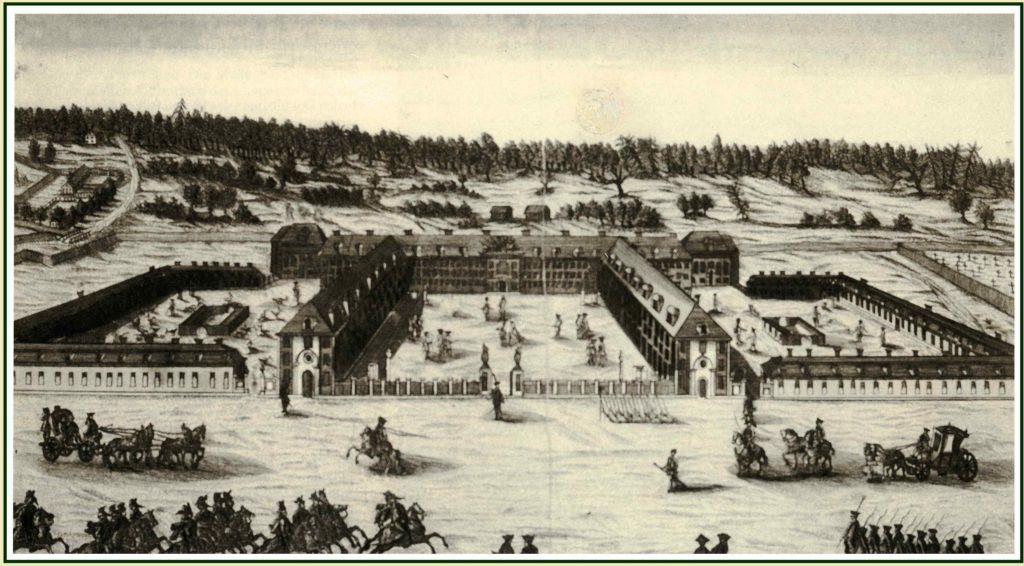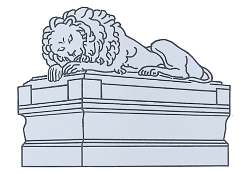The Invalids’ Cemetery dates back to 1748 when it was laid out as part of the adjacent Invalids’ House – built upon the orders of Frederick II of Prussia for Army officers disabled in military service. It became the final resting place for notable and meritorious officers of the Prussian-German army who had fought in the 1813 -1815 Wars of Liberation. Since the latter half of the 19th century it was considered an honour to be buried there and towards the end of the century even notable civilians and nurses from the Augusta-Hospital, a military hospital founded on the initiative by Queen Augusta in 1868 which was situated opposite the cemetery, were also interred there. One of the most spectacular monuments is that of the tomb of the famous minister of war and army reformer General Gerhard Johann David von Scharnhorst (1755-1813) and his family which was designed by Karl Friedrich Schinkel depicting a slumbering lion and decorated with inscriptions and scenes by Friedrich Tieck illustrating Scharnhorst’s life.

The Invalids’ House was closed as a military institution after 1918 and transformed into the Invalids’ House Foundation. Sadly about 3000 graves older than 30 years, for which no more fees had been paid, were levelled over in a large-scale operation after 1925 thus decimating the number of graves by half.
There was mixed feeling about the cemetery during the years of the national socialist dictatorship. On the one hand, the Prussian elite were regarded as reactionary and thus the cemetery faced being built over. On the other hand, plans existed to exhibit the most important tombs in an enormous vaulted “Soldiers Hall”. Not only were some representatives of the Nazi regime buried there – including Reinhard Heydrich, Reichsprotector of Bohemia and Moravia, head of the security police and security force, chief organiser of the mass destruction of the Jews, Fritz Todt, Reich Minister for Weapons and Munitions, some Party members and followers e.g. General Rudolf Schmundt who died from injuries incurred by the attack on Hitler on 20th July 1944 but also personae involved and murdered in the resistance movement such as the last commander of the Invalids’ House, Colonel Wilhelm Staehle.
A plaque commemorates the death of Lieutenant-Colonel Fritz von der Lancken who was executed on 29th September 1944 at the prison Berlin-Plötzensee after the failure of the plot against Hitler. His villa in Potsdam served as a meeting place for those involved in the assassination attempt on Hitler.
During the Nazi regime, Werner von Fritsch, former member of the Army High Command (and second German general to be killed in WWII), air ace Werner Mölders and Luftwaffe General Ernst Udet were also buried there. Mölders died in a plane crash on his way to Udet’s funeral and they were buried opposite each other close to the “Red Baron” Manfred von Richthofen.
Assassinated by members of the extreme right of the Freicorps in 1922during the Weimar Republic, the German-Jewish statesman and Minister of Foreign Affairs Field Marshall Walter von Reichenau was also interred here during the Nazi regime.
At the end of WWII the Invalids’ Cemetery, the second oldest military cemetery in Berlin, was confiscated as a military object by a resolution passed by the Allied Control Council, possibly because it contained memorials to prominent Nazis and to Prussian military history. However, business continued as usual for the time being. On 17th May 1946 the Allied Control Council issued the order to remove all military and national socialist monuments, also on cemeteries, and this resulted in the removal of the grave markers of Heydrich and Todt, although their bodies were not disinterred.
In May 1951 the Invalids’ Cemetery was closed by resolution passed by the city council of East Berlin and all expired graves from before 1925 to be levelled over. Under the pretext of “Reconstruction”, graves no longer maintained, gravestones destroyed in the war and two damaged mausoleums were cleared and flattened in June 1951. Later it was opened to the public albeit for fours hours, four days a week. When the building of Berlin Wall began on 13th August 1961, a further step towards the destruction of the Invalids’ Cemetery was initiated
The sector border ran through the middle of the Spandau Shipping Canal right on the boundary of the cemetery. Entire sections were cleared to allow for the border strip amounting to about a third of the cemetery. Watch towers, floodlights, shooting ranges and facilities for guard dogs were erected with a concrete road built over the graves. The department of “Clearage” of the district Berlin-Mitte registered the demolition of 94 tons of monuments as well as 26, 5 tons of gravestones from graves which had not even expired. Three tons of grave railings were dismantled and removed.
In June 1973 ownership fell to the nearby Government Hospital and garages and a car park were constructed. The so-called fourth Generation of the Wall instigated further destruction from 1972 – 1975. In 1975 graves were razed once more including the tomb of the master builder Carl Rabitz which was fashioned in the form of an Attic Temple. Graves with exclusive rights for permanency or those which had not yet transpired were anonymously relocated. The only reason why the cemetery was not completely destroyed was due to figures such as Gerhard von Scharnhorst and Friedrich Friesen, who died in the Wars of Liberation, whom the GDR sought to monopolize ideologically as the freedom fighters.
Developments since Reunification
Despite the devastation caused during the GDR, at least 200 tombs and gravestones still exist owing to the efforts of the East German Office for the Preservation of Historical Monuments. These graves proffer a virtually complete example of Berlin sepulchral culture of the past 200 years. In addition to early classical attestations, one finds examples of Art Nouveau and New Objectivity. Having recognized this, the Invalids’ Cemetery was bestowed monument protection under the laws of the Preservation of Sites of Historic Interest issued by the Berlin Monument Authority as early as 1990 following the Fall of the Wall.
In 1992 a group of active voluntary monument curators founded the Invalids’ Cemetery Association “Förderverein Invalidenfriedhof e. V.” and accompany and support work carried out by municipal authorities.
Of special interest was the provisional protective cover over the tomb of General von Scharnhorst erected by the Berlin Monument Authority in 1990. Further conservational measures were the restoration of the indispensable and defining elements of the Invalids’ Cemetery. Thus the Park and Garden Conservation Office replanted the main avenue with linden trees at the end of 1991. The following year the rather distinctive tomb of the first Commander of the Invalids’ House, Gustav Friedrich von Kessel, which lies prominently at the centre of the intersection of the main avenue, was restored.
Also worthy of mention is the restoration of numerous graves of important, for instance, of the generals von Boyen, von Scharnhorst and von Winterfeldt. Between 1997 and 2001, the Foundation German Class Lottery approved considerable funds for the cemetery resulting in the restoration of more graves. This included special restoration work on excavated gravestones.
The completion of the Lapidarium in the services yard was outstanding as well as the complete restoration of the historical wall along the Spandau Shipping Canal which once marked the border to West Berlin. This was financed with funds from the Federal Government Commission for Cultural Affairs and the Media which additionally financed numerous projects in the cemetery in the following years. Particularly precious original stones are stored in the Lapidarium. The above measures were completed in time for the 250th anniversary of the Invalids’ Cemetery in November 1998.
Institutional provider from 1991 to 1995 was the Berlin Office for the Preservation of Historic Gardens and the Berlin Monument Authority respectively. Since 1995 the cemetery has been owned and maintained by the Berlin-Mitte Office for Nature Conservation and Parks which also participates in restoration measures taken. However, without the immense dedication, commitment and support by the Invalids’ Cemetery Association, numerous Family Associations and individual persons, all restoration of the cemetery undertaken since Reunification would not have been possible.
